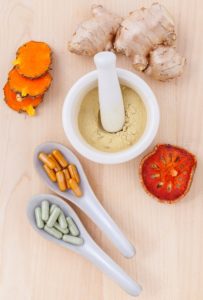 Many of us enjoy a cup of herbal tea before bedtime to feel cozy, calm our racing mind, or open up clogged sinuses to help us sleep.
Many of us enjoy a cup of herbal tea before bedtime to feel cozy, calm our racing mind, or open up clogged sinuses to help us sleep.
The same approach is used by practitioners of Traditional Chinese Medicine, although they bring a medicinal outlook. Herbs are used frequently in treatment by your TCM practitioner, taken as tea or pills. Sometimes an herb’s special effects are released through burning; while smoke infuses the room the herb container may be waved over your body to help it release poisons and pains.
The Chinese Materia Medica, a reference book used by TCM practitioners to identify more than 5,000 plant products, along with some mineral and animal extracts. Most practitioners regularly use just 200 to 300.
One difference between Western medicine and Traditional Chinese Medicine, is that each prescription that an herbalist writes is specific to the patient being treated. Every person is a different size, or has slightly different symptoms, and the TCM practitioner will create a combination of herbs just for that person.
The treatment may be a dose of one type of herb, or a combination of two or more, depending on what the patient’s body reveals.
As with all complementary medicines, including acupuncture, the goal is to identify what is out of balance in the body and then encourage the body to heal itself.
Ginseng is one of the most widely used herbs in treatment. It strengthens your life force, or Qi, and addresses shortness of breath, stomach unease and even heart issues.
Licorice is commonly used as a sweetener or “harmonizer” in herbal prescriptions.
Rhubarb root is a laxative when it is boiled for an hour or more to reduce its toxicity.
Angelica Sinesis, or Dang Gui, relaxes muscles, which makes it useful in treatment of high blood pressure and heart issues. It has also been used to boost fertility in women.
Coptis Chinensis is also known as Chinese goldthread. It is very bitter and is used to treat digestive ailments.
Ginger, known as a spice in the U.S., has been used for 2,000 years or so to improve blood circulation, treat diarrhea, and as a cough suppressant.
The National Center for Complementary and Integrative Health, a department of the National Institutes of Health, has not conducted as many studies of herbal treatments as it has of acupuncture and other treatments. The center advises patients to tell all your health care providers about any complementary health approaches you use. Give them a full picture of what you do to manage your health. It also warns that some Chinese herbal products sold in stores have been contaminated with drugs, toxins or heavy metals.
Trained TCM practitioners will be able to tell you why they are prescribing herbs, where they come from, what they will treat, and how they work. While many herbs contain the same ingredients as modern medicines, the levels of potent chemicals in herb treatments are lower. That means they can be controlled, but you also may need to take the treatment longer.
As with all complementary medicines, your practitioner will spend time with you to ask questions and observe in order to make a correct diagnosis before prescribing a treatment that will allow your body to regain harmony and heal itself.
Connect with Us!
FacebookLinkedin